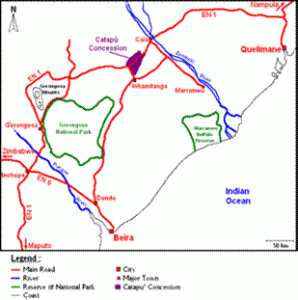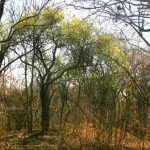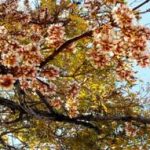TREE LIFE
February 2012
MASHONALAND CALENDAR
Sunday 19th February: A repeat visit to Gosho Park, Marondera. A chance to see this interesting venue in the rainy season.
Saturday 25th February: Afternoon visit to Tambira Galleries and Wild Tree Café (next to Arundel School).
Full details of the directions to each venue, and in the case of Gosho Park the entrance fees, will be sent to you all in early February.
NEW BEGINNINGS
With this February edition of Tree Life I start in my new position as editor. A big thank you to Bill Kinsey for his sterling job as editor over the years, I hope to be able to keep up to his high standard. Please continue to send in any interesting tree news and information that you may come across in your discussions and readings.
-Ed.
WELCOME TO OUR NEW EDITOR, DR ISLA GRUNDY
It is with great pleasure that I welcome Dr. Isla Grundy as the new editor of Tree Life with effect from this February 2012 issue.
Isla is a returning resident of Zimbabwe, having worked as research officer for the NGO SAFIRE in Harare from 1996 to 1998. She then worked for the University of Oxford (1998 – 2001) setting up Community Forestry degree and diploma courses in South Africa, and afterwards at the University of Stellenbosch (2001 – 2003) as a senior lecturer in Community Forestry.
Isla then went to the land of the Eucalyptus as an Agroforester for Primary Industries Research at the Rutherglen Research Institute in NE Victoria (2003 – 2006) and for the federal research body CSIRO in the Cairns office in Far North Queensland (2007 – 2010). She has been back in Zimbabwe since November 2010 and has been a regular attender at our outings. Isla tells me that she is very pleased to be back home and now has, like many others, three jobs: Senior Ecologist for Bio-Innovation Zimbabwe, working to commercialise some of Zimbabwe’s under-utilised plants (such as Baobab, Marula and Masau) for the benefit of the rural poor; lecturer in the Dept BioSciences at UZ; and a consultant for the firm EcoLivelihoods.
Isla has degrees in Forest Ecology and Management (PhD from Oxford); Forestry and Land Use (MSc from Oxford) and Tropical Resource Ecology (MSc from University of Zimbabwe).
On behalf of the Society I would like to thank Isla for taking on the role of editor of our newsletter.
-Mark Hyde
THE NAME ACACIA LOST TO AFRICA
At a Nomenclatural Session at the XVll session of International Botanical Congress (IBC) in Vienna in July 2005 it was agreed that there would be a change to the type species of Acacia so that Africans, South Americans and Asians could no longer use the name Acacia for their trees.
Acacia is a genus of shrubs and trees belonging to the subfamily Mimosoideae of the family Fabaceae, first described in Africa by the Swedish botanist Carl Linnaeus in 1773. The generic name derives from ακακία (akakia), the name given by early Greek botanist-physician Pedanius Dioscorides in about 50AD to the medicinal tree Acacia nilotica in his book Materia Medica. This name derives from the Greek word for its characteristic thorns, ακις (akis, thorn). The species name nilotica was given by Linnaeus because of the tree’s best-known range along the Nile river. Acacias are pod-bearing, with sap and leaves typically containing large amounts of tannins and condensed tannins that found use in many species as pharmaceuticals and preservatives. There is also mention of the use of Acacias as building material in the bible, so its application to African trees goes back thousands of years.
The genus Acacia previously contained roughly 1300 species, about 960 of them native to Australia, with the remainder spread around the tropical and warmer temperate regions of both hemispheres, including Europe, Africa, southern Asia and the Americas. However, in 2005 the genus was divided into five separate genera. The name Acacia was retained for the majority of the Australian species (948), ten in tropical Asia, one or two in Madagascar and seven in the Pacific Islands. Most of the species outside Australia, and a small number of Australian species, were reclassified into Vachellia and Senegalia. The two final genera, Acaciella and Mariosousa, only contain about a dozen species from the Americas.
Many non-Australian species tend to be thorny whereas the majority of Australian acacias are not. DNA evidence has now shown that the African Acacias and Australian Acacias do not share a common ancestor and thus cannot be lumped in the same genus. Logically the Australians should have been the ones to rename their species, but at the Vienna Nomenclatural session in 2005 (under much controversy and skull duggery according to African scientists) the type species was moved from an African species to an Australian one.
Taxonomists the world over believe that a procedural error had crept in at the Vienna conference and that the Australians should never have been able to lay claim to the use of the name Acacia when there was an overwhelming case for the name to be reserved for African plants. They strongly felt there should be a fight against the change and at the following Nomenclature Session that was held at the Internal Botanical Congress in Melbourne in Australia in July 2011, six years after the Viennese decision, they wanted to discuss the protests raised. However the decision was carried yet again. African scientists thought it should never have been debated on Australian soil, but rather in a neutral venue where it was not possible for Australians to pack the hall and put the opposers at a serious numerical disadvantage. They were also nonplussed that no discussion was allowed about the questions raised and that the Australian proposers were not open to an amicable compromise put forward by the Legume experts, which would have treated everyone equally. They believe it puts into question the integrity of the Botanical Code which they feel has now become a political and economic tool.
The results of the Melbourne meeting caused huge debate and division globally. Some of those who accepted the split suggested that another generic name, e.g. Afracacia or Acanthoacacia, should be used for African Acacias, with the submitting of a conservation proposal to be approved or disapproved in six years. Others believed that the name Vachellia already existed and had priority.
For those who accepted the necessity of dividing traditional Acacia into five genera, two alternatives within a normal nomenclatural framework were proposed: 1) writing and vigorously promoting and defending a proposal to reverse the conserved typification of Acacia and reinstate the original type species A. nilotica; or 2) accepting the results of the Vienna and Melbourne Congresses and adopting another name (such as Vachellia) for the species previously assigned to African Acacias. There is also the option to ignore the Viennese decision altogether by continuing to call all the African plants Acacia, since there is nothing legally binding about the outcomes of an IBC. A number of scientists plan to boycott paper reviews or journals that insist on taking up the name Vachellia.
There is also controversy over the decision of some taxonomists to ultimately take the protest to an International Court of Law. Some believe there is a real issue in terms of intellectual property rights and feel that only a judicial process – where evidence is fully presented on both sides culminating in a judgment – is the only way there will ever be a fair hearing and resolution of the matter. Others feel that under no circumstances would they support such a move because they value the fact that the Code had always been enforced solely by the voluntary acceptance of its users, a status that they do not want to abandon.
Many African scientists are convinced that the name change will have very negative scientific and economic implications for Africa, seriously affecting the end users of plant names (ecologists, physiologists, environmental managers, educators and horticulturalists). Some felt it clearly showed Nomenclatural Imperialism at work in the name of big money and First World interests, when the Australian population of some 14 million people managed to walk over the needs of some 2 billion people in Africa, many of whom do not know and would not understand why the name Acacia was stolen from them.
However, African scientists have not given up the fight for the name Acacia, so it remains to be seen what their next moves will be.
-Isla Grundy
2nd ANNOUNCEMENT: PROPOSED TREE SOCIETY OUTING TO MOZAMBIQUE 7-13 APRIL 2012
The Tree Society will visit Catapú forestry concession of TCT Dalman in Sofala Province, central Mozambique from April 7-13, 2012, including the Easter weekend. We have booked at M’phingwe (pronounced “Impingwe”) Camp. M’phingwe is the Sena name for the african blackwood, Dalbergia melanoxylon, also known as zebrawood, found within the camp. Accommodation is provided in comfortable log cabins for about $20 per person per night and there is a restaurant with drinks and meals available. Camping and self catering are not permitted in accordance with Mozambique law. M’phingwe Camp can accommodate up to about 25 people and I would love to share this magic place with as many people as can manage to make the trip.

Map to Catapu
All prices are given in Meticals but it is absolutely possible to pay in US$. The following prices are approximate and based on the present rate of about 26 MT to $1. There are two slightly more luxurious cabins, 21 and 23, each with two, three-quarter beds, en suite bathrooms and separate seating areas which cost $60 per night. There is a restaurant with drinks and meals available. Meals will probably cost up to about another $20-25 a day depending on whether you have steak or spaghetti. Coke and beers are $2—3 each. Wine and spirits are also available.
Fuel is about 35—45 MT per litre. There are fuel outlets at various places along the way and my experience has been that they are more likely to have fuel available than those in Zimbabwe. For those taking their own cars, the form for the TIP costs 25 MT and car insurance costs R150 or about $US 25.
Catapú is 700 km from Harare and the road is tarred all the way. I have often done it comfortably in a day. It would be possible to break the journey at Casa Msika on Chicamba Dam if people wanted to. For visits to some of the places around the area, a sturdier vehicle than a sedan will be needed and I hope that some people will be coming in such vehicles and will be prepared to share transport.
I look forward to welcoming you and sharing all the exciting trees and things we have at Catapú.
-Meg Coates Palgrave
Outing to Miombo Park, Christon Bank, January 22nd.
Miombo Park is a private property of some 55 hectares (550 000 m2) covered with pristine Miombo woodland. We first drove up a steep hill to the top where we met Gus le Breton and his wife Amanda, our hosts for the day. The meeting was attended by over 20 members. First Gus introduced us to his domain. The property is a totally unspoiled miombo environment with zebra, impala and other game species. Gus explained that we would first go down to the stream at the bottom of the property, where the biodiversity is richer than at the top . Some people went with 4-wheel drives and some decided to go by foot.
The altitude at the top is 1486 m, the bottom is 1350 m, a drop of 136 m in what feels like just about the same horizontal distance, definitely not a road for your limousine! The valley is delightful and one could only dream of having a little cabin tucked away under magnificent trees.
We started our visit at 17°36,619” S; 30°59,129” E, there Mark handed us over to Meg who led us around the valley. The list of the trees below was described to us by Meg in some detail.
Sapindaceae, Allophylus africanus, African false-rhus. Mimosoideae, Acacia polyacantha, Hook thorn; Acacia sieberiana, Flat-topped thorn. Ulmaceae, Celtis africana, White stinkwood. Combretaceae, Combretum molle, Soft-leaved Combretum; Combretum erythrophyllum, River Combretum; Terminalia stenostachya, rosette cluster-leaf. Araliaceae, Cussonia arborea, Cabbage tree. Ebenaceae, Diospyros lycioides, Red star apple; Euclea divinorum, Diamond leaf quarry. Sterculiaceae, Dombeya rotundifolia, Wild-pear. Papilionoideae, Erythrina abyssinica, Luck bean tree; Indigofera rhynchocarpa, Hockey-sticks. Euphorbiaceae, Erythrococca trichogyne, Twin red-berry; Flueggea virosa, Snow-berry. Proteaceae, Faurea saligna, Beechwood. Moraceae, Ficus sur, Cape fig. Tiliaceae, Grewia stolzii, Green petal grewia. Caesalpinoideae, Julbernardia globiflora, Munondo. Celastraceae, Gymnosporium senegalensis, Confetti tree. Anacardiaceae, Searsia longipes, Large-leafed crowberry. Bignoniaceae, Stereospermum kunthianum, Pink jacaranda. Loganiaceae, Strychnos spinosa, Spiny monkey-orange. Myrtaceae, Syzygium guinenese, Woodland water-berry. Meliaceae, Turraea nilotica, Miombo honeysuckle-tree. Rhamnaceae, Ziziphus mucronata, Buffalo-thorn.
This list is by no means comprehensive but the quality of Meg’s comments on the various species meant that we looked at more than make up for the quantity. There is no doubt that, given the time, the place would yield many more species.
At noon we drove (walked!) back to a delightful stone refuge with a veranda overlooking the valley below to have lunch. After lunch Mark and Meg and a few others identified another 20 or so species near the cottage at the top.
This was a new venue for the Tree Society and very well worth it.
-J-P Felu
FURTHER HERBARIUM FUMIGATION APPEAL
In September 2009, members may recall that we launched an appeal for funds to enable Zimbabwe’s National Herbarium to be fumigated.
The response was highly gratifying and the funds raised enabled us to carry out 4 fumigations at approximately 6 monthly intervals. The cost of a single fumigation is US$ 350.
In the intervening period, the financial position of the Herbarium has remained weak and it appears that further support for continuing fumigation will be necessary.
I am therefore re-opening the request for funds and would ask every member to consider making a donation towards this important appeal, the purpose of which is to prevent the plant collections deteriorating through insect damage.
This appeal is not in any way limited to Tree Society members and I would ask you to spread the word to your friends and any potential donors.
Donations can be made in cash to the Treasurer, Bill Clarke, to Terry Fallon, myself or any committee member.
-Mark Hyde
TREE OF THE MONTH
Catunaregam taylorii

Catunaregam taylorii
Catunaregam taylorii belongs to the Rubiaceae family. As Rubiaceae is the most widespread family in the region we will start with a short reminder on the characteristics common to the family which, worldwide, number some 6 500 species. The leaves are simple, entire and are always opposite, sometimes in whorls. Stipules are present and interpetiolar (between the petiole and the stem), they normally leave a scar across the stem.
Catunaregam taylorii (previously Xeromphis obovata) is a shrub or small tree with sparse foliage occurring in bushveld often in dense stands in rocky areas. Branchlets have paired, straight, decussate spines. The leaves are dark green, opposite or clustered on reduced lateral shoots, oval to obovate, up to 38 x 25 mm. They can be hairy on both surfaces or almost hairless. Venation is whitish translucent when viewed against the light; apex rounded; petiole up to 3 mm.

Catunaregam taylorii, flowers
Flowers form in axillary groups of two or three. They can be up to 20 mm in diameter, white fading cream to yellow. The fruit are hard, oval, up to 25 mm long, crowned with the persistent remains of the calyx (inferior ovary), green turning to yellow then brown. The fruit is edible and used medicinally particularly in ayurvedic medicine, where it is reputed to be emetic (induce vomiting), anodyne (pain killer), anti-inflammatory, sudorific (causing sweating), anti-ovulatory, antispasmodic, abortifacient (causing abortion), anti-cancer, insecticidal, sedative (calming) and more. One is inclined to wonder why we have anything else in our medicine chest !
Perhaps more seriously, it contains mannitol and is useful in the treatment of skin diseases and allergies. It is a blood purifier, it is said to cure acne and eczema. The plant is also browsed by game and stock. For anyone wishing to become an instant millionaire we spotted the plant on the way to the valley at Miombo Park and it is dominant in some areas near Tshalimbe (not far from Rhodes’ grave in the Matopos). All the pimply girls of Harare would rush to you for this miracle cure for the most serious problem of their lives!
Why we do not use it in gardening is puzzling, it tolerates droughts and frost, has exquisite flowers and attractive fruits.
J-P Felu
TREE SOCIETY’S WEBSITE
The Tree Society’s website is: http://www.lind.org.zw/treesociety/index.htm
There you will find general Tree Society news and a list of nurseries in and around Harare that sell indigenous trees.
NATIONAL TRUST OF ZIMBABWE
We have received details from the National Trust about their 2012 calendars and their annual newsletter. Should any member be interested in either, please contact Lin Goncalves directly by email: lingoncalves@zol.co.zw.
CHAIRMAN MARK HYDE



